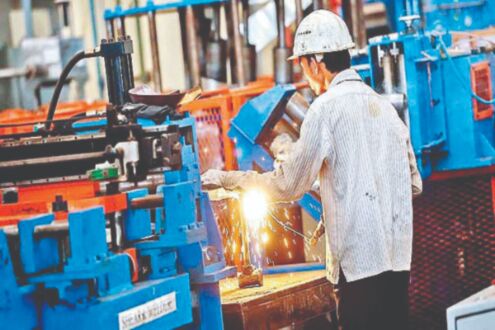Ladder for development
MSME sector can be leveraged for both domestic needs and exports to provide the much-required boost to the national economy, once the roadblocks are removed

The MSME sector remains the largest source of employment generation globally. In India, it has pioneered the manufacture of consumer, industrial, agro-based and handmade products along with equipment, machinery and components. The sector is also playing an important role in increasing demand-supply, foreign exchange, and the pace of development of the country.
MSME sector employs around 11 crore people and contributes about one-third of the GDP. Apart from this, the sector accounts for about 50 per cent of India's exports. Currently, 6.34 crore MSME units are functioning across India with their numbers increasing in recent years.
The pandemic and the lockdowns have adversely affected the MSMEs. Some of the migrant labourers who went to their villages have still not returned to work. As a result, some MSMEs haven't started working yet or are not working to their full potential. In the states like Maharashtra, Punjab and Kerala, Covid infections are on the rise again, causing trouble for the sector.
Pandemic has slowed the pace of production of precious stones, diamonds and jewellery, clothes, readymade garments, readymade food products, chemicals, leather products, machinery, automobile equipment etc. by the MSME sector. The supply chain has also not been fully opened yet, inflicting lag on the export front. Though the situation is improving, the sector is not able to give its best as it faces a host of other challenges including fierce competition from big industries, marketing issues, problems in getting loans, roadblocks in importing raw materials, etc.
Capitalizing on the potential of the MSME sector by making it export-oriented could lead to an increase in foreign exchange, boost employment and accelerate development. This would come only through financial assistance by the Government, tax cuts, duty reduction etc.
Also, MSME is the largest sector to cater to domestic needs. This sector can become a medium to make the country self-reliant if the Government comes up with infrastructure, relevant policy interventions and incentives to increase production.
MSME sector can also be developed in tiers-III towns and many agro-based industries can be established in cities nearby villages. If the Government makes firm marketing arrangements around the availability of roads and electricity in every corner of the country then naturally the MSME sector can be developed in the cities near villages. This will drastically reduce the number of workers migrating to other states. However, to bring about such positive change, certain roadblocks to development will have to be removed.
For the smooth development of the MSME sector, the Government has changed the definition of investment and total turnover in the year 2020. MSME sector has also benefited from the Atma Nirbhar Bharat package. Today, on the instructions of the Government, collateral-free loans are being given to the sector. However, for this, traders have to fulfil certain conditions. Due to the reduction in policy rates by the Reserve Bank of India, banks are providing loans to the MSME sector at low-interest rates. Relief is also being given to the sector in terms of doing business. The income tax department is refunding the excess amount deposited in the government accounts to the traders within a fixed time limit. To make the business transparent in the MSME sector, the Government is also promoting the operation of e-markets, so that corruption is eliminated from the market.
The Budget 2021-22 doubled the government spending on the MSME sector. Anti-dumping duty and excise duty have been cut to enable consumers to buy the required goods at a cheaper rate. Anti-dumping duty is a tariff that the government imposes on imports. It is levied on products whose price is less than the fair market price. Dumping is a process where a company exports products at a lower price. The excise duty is levied on the manufacture of goods. Businessmen who are exporting clothes, leather, and handmade products in large quantities, have been given relief in import duty so that they can import raw materials seamlessly. These efforts are constantly improving the performance of the sector and strengthening the economy.
As per the National Statistical Office report for the third quarter, the GDP has increased at the rate of 0.4 per cent, while the first quarter of the current financial year, 23.9 per cent decline had been registered in GDP. According to the NSO, there was a growth of 3.3 per cent in GDP in the same period of FY 2019-20.
The rating agencies Moody and ICRA have also projected significant growth for the Indian economy in the current financial year. On the other hand, according to the global rating agency Fitch, the target of the deficit projected in the Budget by the Government of India is high, but given the Corona pandemic, this move of the Government can be justified because the upsurge in government spending will increase the fiscal deficit. As per rating agency Standard & Poor's (S&P), the situation of export-focused SMEs is more volatile in the current challenging economic situation. However, through the corrective steps taken in the MSME sector by the Government, the functioning of MSME units is improving.
Before the pandemic, the Government was planning to make the Indian economy worth USD 5 trillion by the year 2024-25, but this dream of the Government was affected due to the COVID-19. However, with the help of the MSME sector, the Government can fulfil this dream, as it is possible to ensure inclusive growth in India by strengthening the sector.
The writer is the Chief Manager in the Department of Economic Research at the Corporate Centre of State Bank of India, Mumbai. Views expressed are personal



